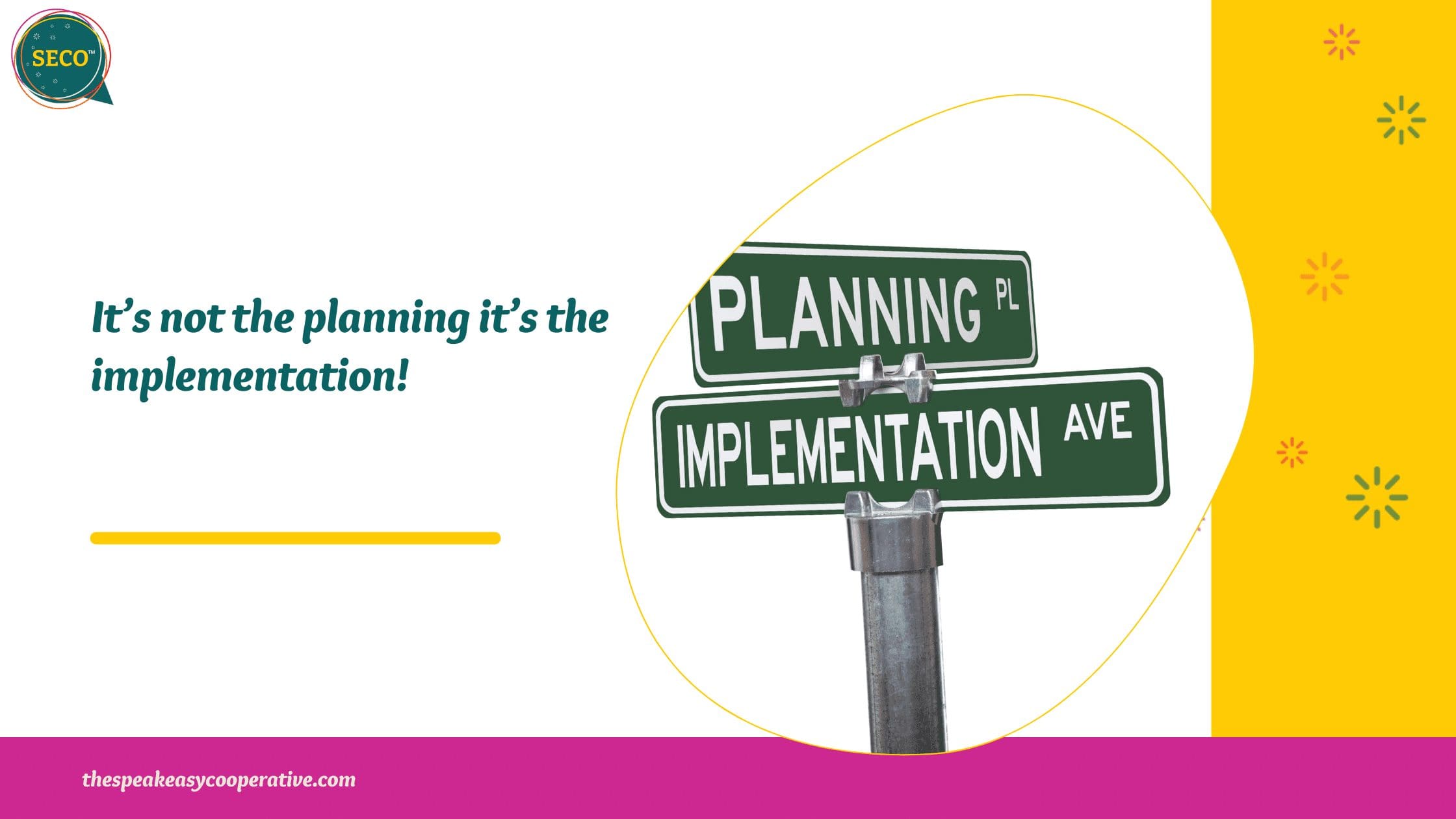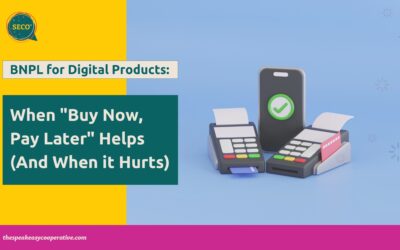It’s not the planning it’s the implementation!
This month, The SpeakEasy Cooperative is talking about planning. One of the themes that keeps coming up is that pesky concept of implementation. Sure, for some, merely the thought of planning makes running for the hills a quality option. For the majority of these savvy business owners, however, the bigger issue is not the planning, it’s the implementation.
Today I will show you five keys to implementation of your plans. Then, I will dive deep into two of them:
Why do we have trouble implementing?
I’ve wrestled with implementing since I was a kid. Ask my poor mother about my (lack of) homework routine all throughout middle school. Growing up, if it wasn’t theater, singing, dance class, jazz band, piano, or choir, well, EFF THAT NOISE.
PFFFT MATH HOMEWORK. WHATEVER ENGLISH ESSAY. YEAHHHH, RIGHT CLEAN ROOM.
In fact, I was failing my gen-ed classes so badly during my first attempt at college, that after breaking up with my then fiancé (what the hell was Michelle doing engaged at 18?! DO NOT ASK. SHE SHOULD NOT HAVE BEEN.), I dropped out.
My “failures”, at their most basic, weren’t around the planning, but the implementation. So, whyyyyyyy?
Five (I am sure there are more but just go with me, here) reasons whyyyyyyy:
Motivation.
We often mistake motivation for a “feeling of readiness”. It is not. Motivation is about “reasons to act.” I wrote a blog about it last month or so that you can read “Why Small Business Owners Struggle With Motivation (And How to Fix it)“. I had lost my “reason to act” because the actions I was required to do were not connected to my larger outcomes.
Larger Outcomes were unclear.
I had no idea what I could be, do, say, achieve. Michelle was pretty lost in the whole “I am a badass” department. I did not have an overarching life goal/mission/vocation. So, I didn’t even know that one day I would own a thriving voice studio, direct award-winning youth theater, and run a personal and business development company with a team of exceptional humans. In fact, if you would have told me that someday this would be my life, I would have laaaaaauuuuuuuughed at you, with gusto. (By the way, not having larger outcomes increases the chance of shiny object syndrome!)
Imposter Syndrome.
(pssssst: Sometimes I *still* have no idea who I can be and what I can do) Sound familiar? The self-talk goes something like this, amiright? “If I plan, and implement, I might actually achieve something. And if I achieve something, that means I could then fail at something. So if I am successful, then I could be a failure, and who am I to be successful, anyway, because I am not good enough, smart enough, have enough education or experience, or am even attractive enough. And I am a shitty [insert role here.] People will find out I am not as cool as they think I am.”
A misunderstanding of what planning actually is.
At the time planning = to-do lists OR writing down grandiose visions. Come to find out, true planning is not bullet journaling or a vision board – while these tools are helpful in planning, these tools are not actually planning.
Trying to plan ongoing life things the same way that we would plan projects.
For more on this, check out the PARA method.
Diving into planning strategies.
Since this month is about planning, I’d like to focus on #2 and #4 from above. I’ll tackle #5 in a later blog. For discussion sake, I am defining “micro-business” as a business that 1) the founder and owner makes all the decisions for, 2) has fewer than 5 W2 employees, 3) has an annual revenue less than $500K, and 4) is not created to be sold, later.
The person I am thinking of is a bright-eyed and powerful individual running a service-based business – like a small multi-teacher studio, an independent studio, an independent SLP clinic, or a copywriter, podcaster, social media management company, or online course creator. You have to make money in order to live, and every decision can impact the bottom line.
What are Larger Outcomes?
The art of larger outcomes.
Over and over again in my work to help people plan, a theme seems to be that many folks have trouble with defining their larger outcomes. They are able to vision out bigger projects (like a recital, a conference, or a podcast series, or buying a new building), but they are not able to connect those things to a larger overarching outcome of how they expect their lives and businesses to impact their world.
Some people call larger outcomes “goals”, some call them “mission and vision”, some call them “summit goals” – I use these terms interchangeably.
Larger outcomes, to my mind, aren’t necessarily S.M.A.R.T goals. Rather, they include areas of continual pursuit.
- Being the vocologist that brings vocal freedom to 1,000,000 hobby singers worldwide
- Changing 200,000 humans attitudes/relationship to money so that they can be free to pursue their wealth goals
- Living a life that consistently provides 30 hours of family, 30 hours of work, 30 hours of play, and 78 hours of rest/sleep/creation a week
These larger outcomes are usually attached to a series of “so that” statements – what some coaches call “the big why”. For my brain, “so that” works better than “big why.”
“I will be the vocologist that brings vocal freedom to 1,000,000 million singers worldwide so that the act of singing continues to bring mental health into people’s homes so that the world is a more peaceful place so that communication brings freedom and health to children so that wounds are healed and people reach their fullest potential.”
What is planning, like, for real though?
What is planning, then, if not just making lists and doing the things?
I’ve been learning “Planning” for a looooong time. It is a SKILL, not a given. Just as we develop our skill in singing, public speaking, bodywork, yoga, baseball, etc, planning takes consistency and repeatability to get good at it.
I define planning as:
Planning:
Michelle Markwart Deveaux
The art of leveraging larger outcomes and breaking them into macro, micro, and nano tasks, on a timeline, and executing these tasks with the commitment and tenacity of a honey badger.
Here’s the trick… many people plan by making a list – which is great as a brain dump! This list, however, is nothing more than a bunch of things that have been paying rent in your noggin with no attachment to a larger goal.
Leaving planning as a list is where the trouble begins. The list winds up looking like a mash up of things like “set up next quarters’ performances” and “buy bananas” and “marketing”. On the surface, that sounds all well and good, except you’ve listed three very different levels of tasking and planning.
Planning is about being able to:
- Distinguish the difference between a larger outcome/goal/project, macro task, micro task, and nano task.
- Put them (if needed) in the optimal chronological order (or be adaptable enough to arrange the order).
- Committing to executing the plan by anchoring it to:
- A dedicated time in the schedule
- A reason to do the task
Think of these goals, macro tasks, micro-tasks, and nano tasks the way you would the way western music theory divides up a whole note:
- The whole note is your completed larger outcome/project/goal.
- This whole note goal is going to be broken up into half note macro-tasks, quarter note micro tasks, and eighth note nano tasks. (In some cases you may even have 16th, 32nd, 64th note pico, femto, or atto tasks!)
- Your note/task values can take all sorts of combinations, as long as you get the whole note goal when they all come together.
Let’s apply this to our above list as an example:
~set up next quarters’ performances
~buy bananas
~marketing
These three things have three different levels of task nestling. Let’s distinguish:
Set up next quarters’ performances is a project, so this will take several levels of nesting and combining of tasks and will most likely require lists within lists. It will require more than one level of task creation, and time-based due dates.
Buy bananas could be part of a project called grocery shopping. Since the project of grocery shopping lives in your brain as “a thing that doesn’t need planning” it sits on the list like a dangling participle with no attached larger outcome.
Marketing isn’t a project, or a dangling participle. It’s an ongoing area of life and/or business that needs attention. A fermata, if you will.
Depending on how your brain is used to working, this could be fine, OR it could send you into cognitive dissonance because now the same amount of brainpower you’ll use to set up your performances is lumped into the same way you’d buy bananas or tackle the consistent need for marketing.
Implementation tends to fail when we handle these three types of planning with the same expectations and systems.
The key is not the planning, the key is implementation…
Or is it?
So when you are tempted to say “it’s not the planning it’s the implementation”, go back to the basics.
Here’s your check-in list for planning vs implementation:
- Check-in on the Motivation – Do you have a reason or are you waiting for a feeling?
- Check-in on the Larger Outcome and the “so that” statements – Are you stuck in nano/eighth note tasks and have not yet attached them to a larger goal/whole note? Zoom out to get a birds-eye view.
- Check-in on the Imposter Syndrome – Remember, it’s always a combo of feelings. Try to pinpoint which one it is, and address that specific gremlin. (REMEMBER?! NO FEEDING GREMLINS!)
- Check-in that you actually planned – Be sure you are not stuck in “list making mode” or in trying to schedule before you plan. Get your plan ready and then schedule it out (even if you already know the due date).
- Check-in that you’re applying the right type of planning to this particular project – If you are planning a project, that is different than planning ongoing tasks. Planning ongoing tasks and work is called a system. And can be created and maintained differently than a project plan.
And here are your friendly reminders:
- A plan is there so you have something to veer from.
- Done is better than perfect.
- Always set a timer. Until you get realllll good at planning, only do short bursts so you don’t spiral out of the stratosphere.
- Distinguish, distinguish, distinguish.
- A to-do list is not a plan, use your lists to make plans.
- Courage is required. #immadoitanyway
- No one can make you be a better implementer. At some point, you have to choose what is more important to you – the implementation or the stuckness.
- No system works until you work the system.
And finally –
Planning is a skill. Be kind and gentle with yourself as you develop this skill.
Comment below and let me know how it goes!
All my BeastyBoss,

P.S. When you get really good at systems (ongoing planning), you’ll have more room for projects (time-based planning). If you’d like to try your hand at Quarterly Planning and Zero-Based Scheduling, please hop over to BestSelf Co and check out their journal and blog. (That is an affiliate link, by the way! All profits from affiliates go toward guest speakers for The SpeakEasy Cooperative.)
P.P.S I did a live training on this, with a Q & A and a hot seat participant this month inside our membership group, The SpeakEasy Cooperative. If you’d like to watch it on the replay, and you’ve been thinking about joining, now is the time. You can register here. See you inside!
P.P.P.S You look great!






Thanks Michelle! I look forward to your newsletters and blogs! You really put words to a sentiment I’ve been thinking about for a long time <3
SUPER happy this is also a blog post for me to read EVERY day. I’ve been feeling that I have so many balls in the air that I just want to lie down with a pillow over my head. Connecting them to a Larger Purpose is so logical, sensical and elegant that I finally see a way out of the morass. Plus, you help us not feel ashamed that this skill isn’t “natural” to some of us. Just dumping that toxic mess is a Godsend. Thank you for the direction and nuts and bolts steps.
This: “Here’s the trick… many people plan by making a list – which is great as a brain dump! This list, however, is nothing more than a bunch of things that have been paying rent in your noggin with no attachment to a larger goal.” Such a useful blog. Thank you.
My pleasure! I am beyond thrilled that it is useful and inspiring (i got your email! Yay)
Hey, thanks for doing all my “so thats” for me. I appreciate it! 😉
Now I need to get back to work and chip away at my 2021 plan.
Sincerely,
A Vocologist Trying to Change the World
You are 100% who I was thinking of. So much love to you, Dr. Nelson!